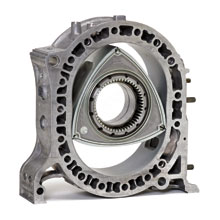How To Perform A Rotary Engine Compression Check

A compression test can be used to determine the condition of the apex, corner, and side seals of the rotary engine.
A key step in determining overall rotary engine health is measuring the engine's cranking compression in the rotor chambers. While not infallible, this test can offer a good indication of the general condition of each rotor's apex, corner, and side seals. Two major factors to consider when performing a compression test are the presence of liquid (water, fuel, or oil) around the seals, and the cranking speed of the engine. An excess of liquid or a cranking speed that is either too slow or too fast will give incorrect readings.
To properly test the engine's cranking compression pressure the battery must be fully charged, the starter in good condition, and the engine must be at normal operating temperature. Testing the cranking compression with the engine cold will most likely produce a false (higher than correct) reading. Remove all four spark plug wires to prevent the engine from firing. Next, remove the leading spark plugs (bottom plugs) only.
Unless you are able to start the engine using a remote engine starter, have an assistant crank the engine during the test. First, crank the engine with the throttle wide open to purge the housings of any liquid. Insert a compression gauge (if so equipped, disable the gauge's feature which retains the highest reading) into one of the leading spark plug holes and crank the engine long enough to obtain at least eight (8) compression pulses. Repeat the test on this chamber at least once more to confirm your readings. Insert the gauge in the remaining leading spark plug hole and repeat the test procedure.
If you see an increase in the cranking compression reading in increments that become smaller at a uniform rate, this indicates even compression on all sides of that rotor. On the other hand, if the cranking compression increases or decreases in erratic steps there is a fault with one or more seals in that rotor. For example, one higher cranking compression pulse followed by two lower cranking compression pulses followed by another higher cranking compression pulse followed by two lower cranking compression pulses strongly suggests the failure of one apex seal, corner seal, and/or side seal set. Continuous low cranking compression pulses strongly suggest the failure of at least two apex seal, corner seal and/or side seal sets.
Based on our experience, with the engine "hot", the compression pressures for a healthy engine are as follows:
- Normal compression - 110-150 PSI
- Minimum acceptable pressure - 75 PSI
- Maximum acceptable pressure difference between chambers - 20 PSI
Note: Race engines (peripheral or bridge port) generally have a normal compression pressure of 90-120 PSI. All other parameters are the same.
Additionally, in our experience, an engine that falls below 75 PSI "hot" cranking pressure will be difficult to start. Because cold cranking pressure is usually higher than a hot engine, the engine may start when cold, but not restart when hot.
Copyright 2007-2024 Racing Beat, Inc ©

